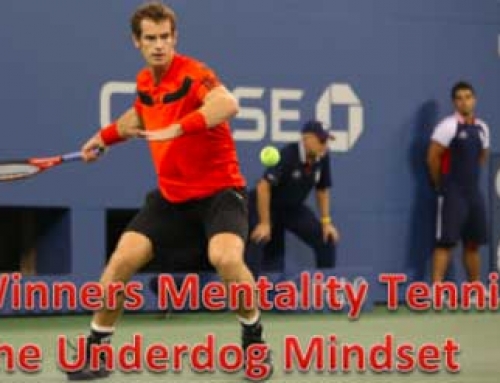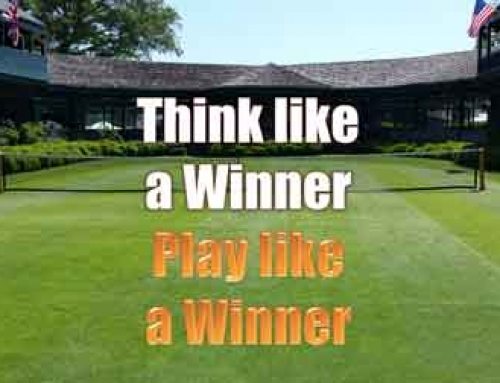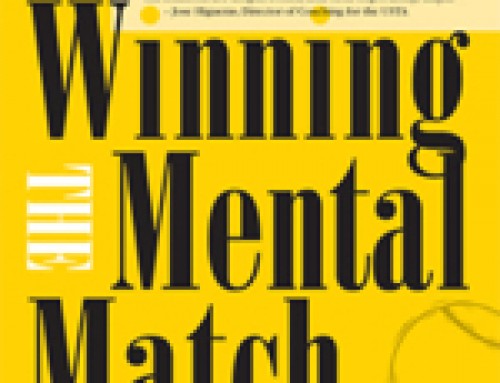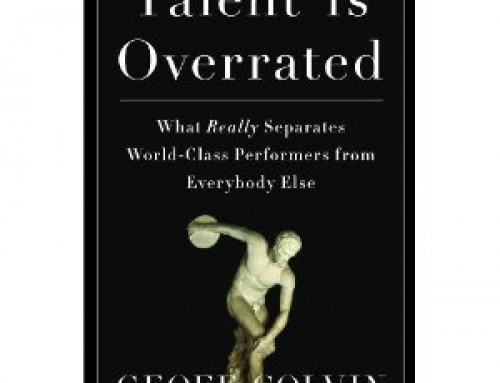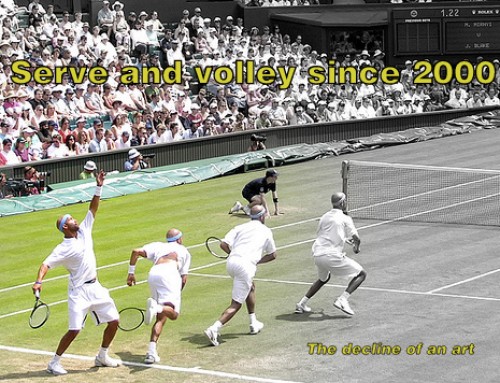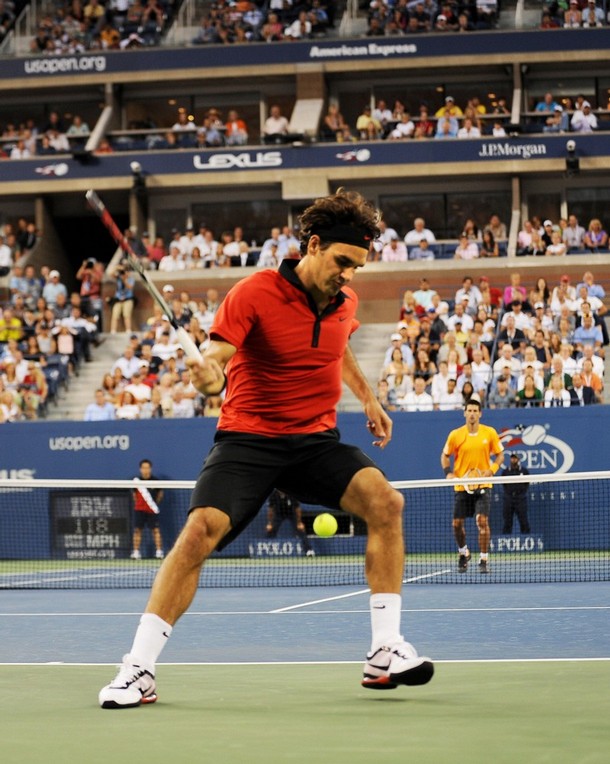 In the US, there is a rating system called the NTRP that classifies players between 1.0—a total beginner—to 7.0—a world class player. Most players fall between 2.5 and 3.5. 2.5 is someone that can get a few balls over the net, but likely lacks spin, consistency, placement, and knowledge of strategy. A 3.5 player is technically more solid, can rally and spin, has some pace, but doesn’t look as polished or as powerful as 4.0 or 4.5. It’s hard to put a single number on a player since they may have on stroke that seems much stronger than their rating and another that might seem a lot weaker, and in the end, the NTRP rating measures wins and losses, not quality of strokes.
In the US, there is a rating system called the NTRP that classifies players between 1.0—a total beginner—to 7.0—a world class player. Most players fall between 2.5 and 3.5. 2.5 is someone that can get a few balls over the net, but likely lacks spin, consistency, placement, and knowledge of strategy. A 3.5 player is technically more solid, can rally and spin, has some pace, but doesn’t look as polished or as powerful as 4.0 or 4.5. It’s hard to put a single number on a player since they may have on stroke that seems much stronger than their rating and another that might seem a lot weaker, and in the end, the NTRP rating measures wins and losses, not quality of strokes.
I’m not here to debate the merits or pitfalls of the NTRP system. I just need an easy way to talk about a player’s skill.
Tennis is a challenging game. If you want to improve your rating especially if your rating is low (around 2.5), you need to have solid technique. Sure, there are athletes with bad technique that nonetheless win matches, but if you’re looking to get better in the long haul, improving your technique is key.
Another way to get better is to learn tennis strategy. Strategy requires analyzing what you can do and what your opponent can do and developing a plan that plays to your strengths and to your opponent’s weaknesses. Surprisingly, many recreational players don’t think about strategy much. They believe winning comes from within, and if they play well, it doesn’t matter what their opponent is doing.
Learning Tennis, Old School
If improving your technique and learning about strategy are two ways to get better, how do you learn more about both?
A few years ago, the only choices for learning about tennis were books on the one hand and expensive tennis lessons on the other.
Since lessons are out of most people’s budgets, books are a popular resource. Unfortunately, many books, even fairly recent books, cover tennis instruction as if the game has not changed since 1970s. Such books would advocated Eastern forehand grip and linear weight transfer, seemingly oblivious to the changes that revolutionized tennis in the 1980s then once again in the 1990s.
Even if books weren’t out of date with modern techniques, they have fundamental limitations. A good tennis pro can spot problems, devise a plan to develop technique and consistency, provide encouragement and provide a real-life visual example which students can imitate. When you use a book, you are your own coach. A book can’t provide a years of teaching experience. It’s difficult to spot problems when you don’t know what to look for, and it’s hard to look at yourself without a camcorder.
A book explains in words. At best, you might see a stroke in a handful of photos. From that, you’re expected to piece together how to his a complex stroke. And that’s tough to do. Books simply lack the dynamism of a real person.
Books have other problems. Suppose you know the secrets of modern tennis. Can you even get a book published? Some publisher would have to think you’re a tennis expert; they won’t publish just anyone. It’s popular to pick ex-pros to write a book, but how much experience do they have teaching? Are they keeping up with the latest techniques? With a lot of money in the bank, there’s not an incentive to learn all there is to give an up-to-date advanced book. Magazines on tennis have often done a better job describing the modern game.
And how often does a book get updated? Lately, Spanish training techniques that emphasize movement have become popular, but are we likely to see any books on this soon? Tennis Channel pounced on the idea featuring Emilio Sanchez teaching these novel techniques, but where are the books?
Beyond Books
Fortunately, tennis instruction recently underwent a revolution. It was part of a revolution that extended far beyond tennis.
The Web.
All of a sudden, if you had tennis knowledge and good video editing skills, you could create and post videos that covered modern tennis as it’s being taught, stuff that’s barely seen in tennis books in the local Barnes and Noble.
The Web has transformed the way people get all sorts of stuff. The idea was simple. Let anyone who had access to an ISP or could host their own web pages do it. This democratic way of letting everyone publish could have lead to chaos, but it didn’t.
The success of the Web required three ingredients. The first was a visual way to view the web: namely, the web browser. Second, the Web needed content. If a book required luck to get published, web pages could by authored by anyone with a computer and a little knowledge of HTML. Third, users needed a way to find stuff they cared about: they needed the search engine.
The rudiments of all three pieces were available by 1995. Content on the Web grew exponentially afterwards. But tennis instruction was still mired because web pages didn’t offer much beyond books. They were still photos and words. Tennis is a visual sport. People want to see how to hit the ball. They wanted video. They wanted slow motion analysis. Web pages in the mid 90s weren’t up to the task.
A Revolution in Tennis Instruction
Tennis instruction didn’t fully take off until a second revolution occurred.
Cheap ubiquitous video.
We’re talking about YouTube and its imitators like Vimeo.
Video had been around since the dawn of the browser, but it wasn’t available freely or easily to the masses. Suppose you took a video. How would you upload it? How much did it cost? It was challenging for the average person to post video.
That changed with YouTube. YouTube brought easy video uploading to the masses and it forever changed how people provide videos to one another.
It’s hard to overrstate how important it was for YouTube to let people upload videos for free. Had they even charged $1 for each upload, it would have greatly discouraged many people and there would only be a tiny fraction of the videos available now. The public reacted by uploading millions of videos covering topics from the educational to the inane to the bizarre.
Tennis instruction didn’t make it to video sites right away. Why not? Remember November 2005? That was when YouTube had its first posted video. And because many homes lacked high-speed Internet and because high quality videos required tons of bandwidth, YouTube made a decision to allow only low-res video.
It goes without saying that low-res video sucks. It’s particularly bad for tennis. Some intrepid posters put videos of classic matches from the 1980s. This was awful on two fronts. The original videos were poor quality and YouTube made it worse because they wanted to scrimp on bandwidth. The poor quality made it hard to see either player or ball making the experience like watching a match though a fogged up windshield. Poor quality video wasn’t good for tennis instruction either.
Fortunately, YouTube’s competitors realized an opportunity. If YouTube failed to deliver higher quality videos, then they would pick up the slack. Companies like Vimeo filled a niche by hosting higher quality videos. Pretty soon, YouTube had to allow high quality, often HD quality, video to compete.
Once high quality video was available, great tennis instructional content was quick to follow. If you had the equipment and the know-how, you could create tennis videos that were worth watching.
Will Hamilton and Adam Sieminski seized this opportunity when they debuted their site, Fuzzy Yellow Balls, around July 2007. They provided high quality tennis instruction with great production values for free. Not only was the tennis instruction visual, it also taught modern tennis, the kind you see on TV. Other tennis sites, many pay sites, sprouted up, trying to offer the “secrets” of tennis that books weren’t covering. These sites feel the pressure to keep updating their content and making it relevant.
What’s Missing?
I’ve got a question for you. Have you ever taken a tennis lesson? You might think instruction videos would mimic a tennis lesson. But they don’t. Most lessons are about drill work. You are given some basic instruction, then plenty of drills. Unless you’re a beginner, you don’t spend much time on technique in a lesson.
By contrast, most tennis videos are about technique. They teach you how you to hit a volley, a serve, a kick serve, a windshield wiper forehand.
Why the big difference between tennis instructional videos and tennis lessons?
A tennis lesson is a customized instruction tailored to you. Although technique videos seem nice and short, it requires lots of drill work to get technique down. A lot.
On the other hand, a tennis video has to work for everyone. It’s far easier to demonstrate correct technique than produce videos covering every potential error. By its very nature, a tennis video can’t be about your specific problems (without being prohibitively expensive, that is). And unlike a lesson, a video is something you can go back to again and again, so it doesn’t matter that learning technique, for many people, is slow and take many lessons to master.
Many tennis players are uninterested in changing their technique. But, even if few people want to change, tennis videos reach the masses. Only a handful need to watch and learn for the video to be successful. When the world can be your audience, even a small percentage of interested people is a large number of viewers.
Recently, videos on strategy have begun appearing. Strategy is a difficult topic. Suppose you’re told that an effective way to return serve is to chip and charge, that is, to slice your return down the line, come to net, and volley for a winning shot. Sounds great, right? But what if you don’t know how to hit the slice backhand, or your slice backhand isn’t accurate enough to hit down the line, or your volley sucks?
Strategy videos tell you how to play in a certain situation, but they often gloss over whether you have the strokes to pull it off. And this observation is critical. Indeed, it’s the thesis of this article.
Strategy is only as good as the strokes you have to back it up.
Even if the strategy is dirt simple, e.g., hit to the guy’s backhand, it can be difficult to execute in practice. For example, your opponent notices you are attacking his backhand. He responds by cheating to his left so he can hit more forehands. He’s just made it harder for you to hit to his backhand. How good’s your backhand? Can you aim that precisely?
Should you even worry about strategy? Maybe you’re a 2.5 player. At that level, hitting a few balls without missing is a success. Should a 2.5 player focus on improving their technique and consistency and give strategy the old heave-ho? Almost surely. It’s not surprising that most strategies assume you have good ball control and good consistency, stuff a 2.5 player isn’t ready for.
The Missing Link
Even if you’re ready to learn about strategy, there’s something missing. On the one hand, there’s plenty of videos on technique. Technique videos describe how to hit the ball, how to turn the shoulders, how to rotate the core, when to swing, how to follow-through.
On the other hand, there is strategy. A strategy video might explain how to attack the backhand, to chip and charge, to serve and volley.
But there’s something missing. Technique and strategy videos are not enough.
What about videos that show you where to hit the ball?
Surprisingly simple, right? Most technique videos don’t address this topic. They tell you how to set up, how to swing, when to strike the ball, and how to follow through. It’s all about you! What about the ball? Somehow, magic must happen because if you have great technique, the ball will surely go where it’s supposed to. Few videos bother tracking the ball after it’s been hit. They don’t talk about how hit a ball down the line vs. hitting it crosscourt.
The missing link between technique and strategy is, simply put, ball placement!
Let’s look at the problem of ball placement. Part of placing the ball lies in good technique, but you still need to hit the ball somewhere.
Perhaps the most common way to teach ball placement is to have students aim at targets on the court. You can spend a few dollars and buy small orange cones at a sports store or a tennis specialty shop, place it on the court, and use that to aim to. If you’re cheap, make a miniature pyramid using three balls to form a triangular base, and one ball sitting on top to form a pyramid and use that as a target.
As you practice your shots, try to hit the target, but do so with your natural stroke. Over time, you’ll build consistency and accuracy.
Although target practice is an excellent way to improve ball placement, you should be a fairly advanced player, say, at 3.0 player or above. If you’re still struggling with the basics, such as hitting forehands and backhands, make the target much bigger.
The problem with aiming at small targets for a beginner is its effect on the hitter. When you’re worried about hitting a target, you tighten up. If you’re going to get better, you need a relaxed swing. Otherwise, you can’t hit both accurately and powerfully.
If you’re a beginner, make bigger targets. Instead of hitting a cone, try to control the ball into the ad court or into the deuce court. Or use several cones to make a large rectangular region to hit into. Bigger targets allow beginners to hit freely and with margin for error, yet still hone ball control. As you get accurate, make those targets progressively smaller.
Hitting Targets
But, let’s assume you’re good enough to aim for cones, that you’re 3.0 or above.
We’re going to look at 7 spots on the courts where you should aim. Seven seems like a lot, but 5 spots are more critical while the other 2 are for specialty shots.
Where are the 5 spots? Let’s assume we’re talking singles. Look at the baseline on your opponent’s court. There’s the left corner (where the sideline meets the baseline). There’s the center mark. There’s the right corner. Those are 3 of the 5 spots.
The other 2 spots are half way between the corner and the center mark.
Let’s label these spots by giving them numbers. 1 is the left corner. 3 is the center mark. 5 is the right corner. 2 is halfway between 1 and 3. 4 is halfway between 3 and 5.
It doesn’t make sense to hit directly to the baseline, so move the 5 spots up 5 feet closer to the net. And you shouldn’t aim for the sidelines (1 and 5 are now on the sidelines), so move Spots 1 and 5 several feet (say, 3-4 feet) to the center mark. Those are the 5 spots you’ll aim for.
Let’s also number the spots on your baseline, 1-5. 1 is the left corner on your side of the court, 3 on the center mark, 5 is the right corner. If your opponent was standing at Spot 1 on his side of the court and you were on Spot 1 on your side of the court, both of you would be on the left sideline (or close to it).
Just to make it easier to distinguish the two sides, let’s call the 5 spots on your side of the court A1, A2, A3, A4, and A5. The 5 spots on the other side are B1, B2, B3, B4, and B5.
Suppose you’re standing at A4. This means you’re in the deuce court, half way between the center mark and the right sideline. If you aim your forehand to B1 or B2, that’s a crosscourt shot. Hitting to B3 is up the middle. Hitting at B4 doesn’t exactly have a name. Hitting to B5 is hitting up the line.
If you’re standing at A2 and hitting a forehand, then hitting to B1 is an inside-in shot, as is hitting to B2. Hitting to B4 or preferably B5 is hitting the ball inside-out.
Let’s label a few other spots. AS1, AS2, AS3, AS4, AS5 are the same five spots on your side, but at the service line (that’s what the “S” stands for–service line). BS1, BS2, BS3, BS4, and BS5 are the analogous spots on your opponent’s court. We only care about two spots: BS1 and BS5.
BS1 is where the left sideline meets the service line (or a few feet to the center). BS5 is where the right sideline meets the service line (or a few feet to the center).
If you’re at A4 hitting a forehand to BS1, that’s an extreme forehand angle. Nadal often hits a forehand from A2 to BS5, a sharply angled inside-out shot (if he were a righty). For now, don’t worry about BS1 and BS5. Add it to your repertoire as you get better.
If you’re at A4, hitting a crosscourt forehand means hitting to B1 or B2 (it’s really more general than that, and is anywhere in your opponent’s deuce court). It’s funny, but many pros tell you to hit crosscourt. Crosscourt is huge. So let’s distinguish between B1 and B2. A shot from A4 to B1 is a wide-angled crosscourt forehand. A shot from A4 to B2 as a shallow-angled forehand. A shot from A4 to BS1 is an extreme-angled forehand, which we won’t discuss much since it’s an advanced shot.
What’s the difference between hitting to B1 vs B2? In tennis, you can trade angle for pace. The more angle you have, the less pace you need for it to be effective. If you aim to B1, you create a bigger angle, which means your opponent has to run more. Furthermore, there’s more court to hit if you aim for B1 since it’s a bigger diagonal If you want to learn a crosscourt shot first, learn to hit to B1.
Male pros often hit to B2 (in a crosscourt exchange) from A4. Why would they hit with such a shallow angle? Why not hit a sharp angle to B1 or even sharper to BS1? B2 is a neutral rally shot. At the pro level, not every shot a player hits is a winner. Some shots are meant to keep one more ball in play and wait for the error.
At the pro level, hitting to B 1 often escalates the play from neutral to offensive. With that angle, a pro might respond with a down-the-line shot, or a sharp crosscourt. Pros will bide their time before they start taking more aggressive shots so they can find the shot they want. On the other hand, a recreational player is better off aiming to B1 because they can take advantage of the angle. If you hit to B2, then you have a safer shot, but a good opponent can hit that shot hard and start pressuring you.
Let’s see how strategy combines with ball placement. A common but effective strategy is to hit to your opponent’s backhand. If you’ve been practicing your backhand, then you’ll stand at A3 (center mark), recognize the backhand, move to A2 (half way in the ad court) and practice shots to B4 and B5. As you get better at both, then you’ll have more confidence hitting them in game situations.
If your opponent starts to cheat to his left and stand at B4 so he can hit more forehands, you can aim the ball at B5, or if you’ve been practicing, hit to BS5. By having a solid handle on hitting to these spots, you can now apply the “hit to the backhand strategy”. If you don’t have good ball placement, then this strategy is harder to implement.
How the Pros do It
Let’s conclude by seeing how a pro like Roger Federer combines ball placement with strategy.
Roger Federer has a superb one-handed backhand, but his forehand is a much bigger weapon. Players have been known to attack Federer’s backhand, so Roger counters this by his tremendous agility to play as many shots to his forehand as possible. This means, he cheats to A2 leaving a great deal of court open to his right.
Most players who move to A2 are looking to hit to B5 or to BS5, that is, to hit an inside-out forehand. A pro may realize this, and start to move to his left when Roger moves to his left, anticipating the inside out shot.
Roger has therefore developed two complementary shots. Not only can he hit the inside out shot (he usually aims to B5 or halfway between B5 and BS5), but he can hit the inside-in shot, which is hitting from A2 to B1 or even to B2. When Roger moves left, his opponent has to deal with a shot to B5 or B1 and Roger hits this shot very hard, so they can’t easily cheat to their left because Roger can hit inside-in too.
Although Federer is great at both shots, players have learned to hit to his backhand, by aiming for a sharper angle, and to hit the shot to A5 which Roger has left wide open. As Roger has gotten older, he has decided it’s time to beef up his backhand. Like the forehand, Roger needs two good shots off his backhand. If he stands at A2, he needs the standard crosscourt to B5, but he also has to hit B1 well too. In his down years, 2008 and 2009, Roger relied more on the crosscourt backhand. Even his down-the-line backhand was a neutral hard shot. He didn’t hit many winners off his backhand.
Over the 2009 winter break, Roger added more consistency and pace to his crosscourt backhand, but he also regained confidence hitting down the line. While Roger is still happy running around his backhand, he’s decided it’s time to have a more powerful backhand so he doesn’t give up space on his forehand. It’s noteworthy that Roger hit as many backhand winners as Andy Murray in the final.
In the Australian Open final, Murray decided to test the Federer backhand with his own to try to break it down. Federer could have tried moving the shot with his forehand, but his backhand had improved enough that he no longer has to run around his backhand all the time. Federer also used his slice quite a bit, perhaps the best slice in all of men’s tennis. Roger develops his shots in groups so he can handle his opponent’s responses.
Federer’s strategy was built from the strokes he had. While Federer’s backhand is world-class, it was still attackable, so he opted to build a strategy that took advantage of his superior forehand. As Federer worked to improve his backhand, he could employ a new strategy that was not viable before.
Clearly, Federer’s strategy also depends on his opponents. If Roger Federer were playing a college level player, he could serve and volley all the time, or hit slice shots all the time. Strategies that would get him in huge trouble in the pros would be more than adequate against players with far less ability. This doesn’t mean you should do silly stuff with lower ranked players, but that strategy’s effectiveness depends on your opponent’s skill level.
Placement and consistency bridge the gap between technique and strategy. As you can place the ball better and more consistently (preferably without loss of power), you can apply more sophisticated strategies.
A 2.5 player should focus on improving technique. They should work on placing the ball to Spots B1, B3, B5 reliably. 2.5 players should keep strategy simple. Keep the ball in play crosscourt until the other player misses.
As you improve to 3.0 and 3.5, you can start using more strategy,
To conclude, I believe videos that instruct you how to control the shots to different parts of the court, whether it be serve or groundstrokes or volleys, will bridge the gap that lets you connect technique to strategy.



